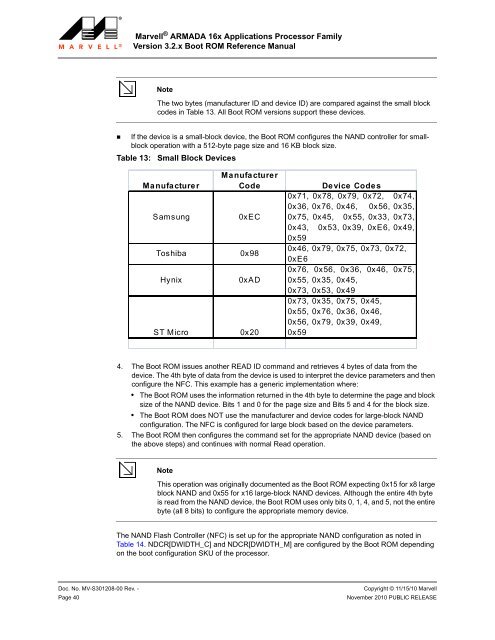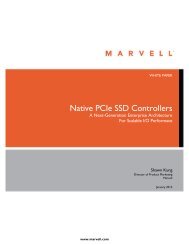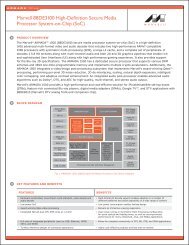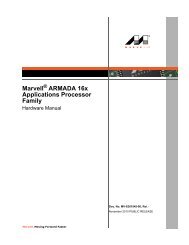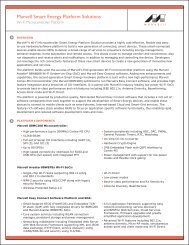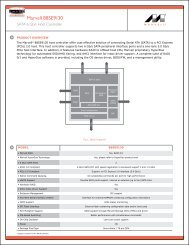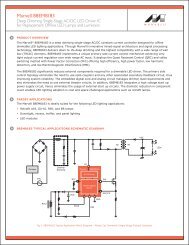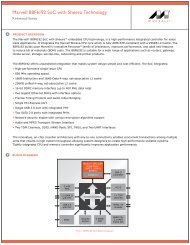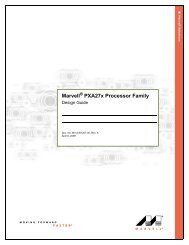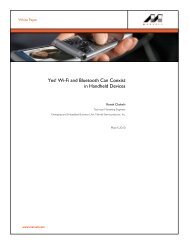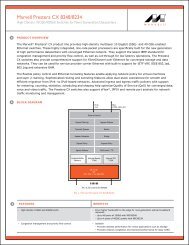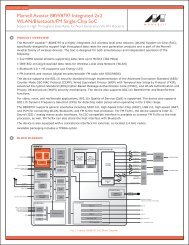Marvell ARMADA 16x Applications Processor Family
7 Marvell ® ARMADA 16x Applications Processor Family ...
7 Marvell ® ARMADA 16x Applications Processor Family ...
- No tags were found...
You also want an ePaper? Increase the reach of your titles
YUMPU automatically turns print PDFs into web optimized ePapers that Google loves.
<strong>Marvell</strong> ® <strong>ARMADA</strong> <strong>16x</strong> <strong>Applications</strong> <strong>Processor</strong> <strong>Family</strong><br />
Version 3.2.x Boot ROM Reference Manual<br />
Note<br />
Note<br />
The two bytes (manufacturer ID and device ID) are compared against the small block<br />
codes in Table 13. All Boot ROM versions support these devices.<br />
• If the device is a small-block device, the Boot ROM configures the NAND controller for smallblock<br />
operation with a 512-byte page size and 16 KB block size.<br />
Table 13: Small Block Devices<br />
4. The Boot ROM issues another READ ID command and retrieves 4 bytes of data from the<br />
device. The 4th byte of data from the device is used to interpret the device parameters and then<br />
configure the NFC. This example has a generic implementation where:<br />
• The Boot ROM uses the information returned in the 4th byte to determine the page and block<br />
size of the NAND device. Bits 1 and 0 for the page size and Bits 5 and 4 for the block size.<br />
• The Boot ROM does NOT use the manufacturer and device codes for large-block NAND<br />
configuration. The NFC is configured for large block based on the device parameters.<br />
5. The Boot ROM then configures the command set for the appropriate NAND device (based on<br />
the above steps) and continues with normal Read operation.<br />
Note<br />
Manufacturer<br />
Samsung<br />
Toshiba<br />
Hynix<br />
ST Micro<br />
Note<br />
Manufacturer<br />
Code<br />
0xEC<br />
0x98<br />
0xAD<br />
0x20<br />
Device Codes<br />
0x71, 0x78, 0x79, 0x72, 0x74,<br />
0x36, 0x76, 0x46, 0x56, 0x35,<br />
0x75, 0x45, 0x55, 0x33, 0x73,<br />
0x43, 0x53, 0x39, 0xE6, 0x49,<br />
0x59<br />
0x46, 0x79, 0x75, 0x73, 0x72,<br />
0xE6<br />
0x76, 0x56, 0x36, 0x46, 0x75,<br />
0x55, 0x35, 0x45,<br />
0x73, 0x53, 0x49<br />
0x73, 0x35, 0x75, 0x45,<br />
0x55, 0x76, 0x36, 0x46,<br />
0x56, 0x79, 0x39, 0x49,<br />
0x59<br />
This operation was originally documented as the Boot ROM expecting 0x15 for x8 large<br />
block NAND and 0x55 for x16 large-block NAND devices. Although the entire 4th byte<br />
is read from the NAND device, the Boot ROM uses only bits 0, 1, 4, and 5, not the entire<br />
byte (all 8 bits) to configure the appropriate memory device.<br />
The NAND Flash Controller (NFC) is set up for the appropriate NAND configuration as noted in<br />
Table 14. NDCR[DWIDTH_C] and NDCR[DWIDTH_M] are configured by the Boot ROM depending<br />
on the boot configuration SKU of the processor.<br />
1<br />
2<br />
3<br />
4<br />
5<br />
6<br />
7<br />
8<br />
9<br />
10<br />
11<br />
12<br />
13<br />
14<br />
15<br />
16<br />
17<br />
18<br />
19<br />
20<br />
21<br />
22<br />
23<br />
24<br />
25<br />
26<br />
27<br />
28<br />
29<br />
30<br />
31<br />
32<br />
33<br />
34<br />
35<br />
36<br />
37<br />
38<br />
39<br />
40<br />
41<br />
42<br />
43<br />
44<br />
45<br />
46<br />
47<br />
48<br />
49<br />
50<br />
51<br />
52<br />
53<br />
54<br />
55<br />
56<br />
57<br />
58<br />
Doc. No. MV-S301208-00 Rev. - Copyright © 11/15/10 <strong>Marvell</strong><br />
Page 40<br />
November 2010 PUBLIC RELEASE


